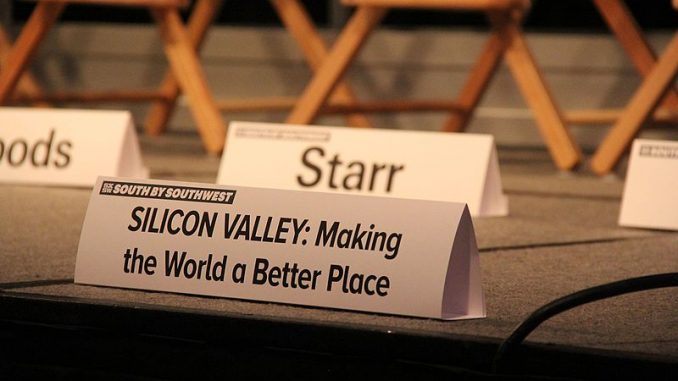
Header: "Sign for the Silicon Valley (TV series) panel" by Daniel Benavides is licensed under CC BY 2.0.
What is meant by the “techlash”? Discuss the public concerns that lie behind the techlash. To what extent can these concerns be addressed by governments, by civil society organisations, and by the technology companies themselves?
Prologue

For many years since the dawn of the consumer internet and tech sectors in the early 90s, Silicon Valley and its activities were subject to fawning profiles and uncritical outlooks by popular culture (Levine, 2018, p. 101).
Rising from the ashes of 60s ‘New Communalism’ (Lusoli & Turner, 2021) came a techno-utopian ideology which spawned a self-fulfilling news-business cycle that informed both journalists and the tech business the former were supposed to be critically reporting on (Karpf, 2018; Levine, 2018, pp. 101-103).
It took a long time for the mainstream political dialogue to move past this kind of neoliberal vozhdism, a process which was hampered by rampant lobbying and funding of U.S. (the centre of the Internet revolution) politicians on the part of the tech sector – which continues to this day (Levy, 2020; Suter, 2021).
Now, we seem to be host to an all-encompassing zeal for regulation, an urgency which started in Europe, with the General Data Protection Regulation (GDPR) in 2016-18, and has taken hold across the West from Australian regulators to the American Congress.
While this new phenomenon of “techlash” is often described as a recent development, it has a long and rich history, right from the start of the Internet as we know it, which is often overlooked in analyses focusing mostly on the more recent revelatory spells experienced by media and political pundits. Based on the seminal recent research by Yasha Levine (2018), Anne Jacobsen (2015) and Sharon Weinberger (2017), it is clear that activists of the past had similar concerns as we have today – that the internet (or the ARPANET) was a tool to track and surveil. Unfortunately, their concerns were swept under the rug by an emerging popular culture that ignored the issues until the scandals once again became too much to bear.
The further history of techlash
As historian Fred Turner argues (2006, as cited in Lusoli & Turner, 2021), the techno-optimism that has clouded the concerning aspects of Silicon Valley can be traced back to 60s ‘New Communalists’, LSD-dropping counterculture hippies who preached computers as “instrument[s] of individual liberation (2021, p. 236) – ideas attractive to the engineers who pioneered the early internet.

However, the New Communalist movement was only one isolated slice of youth. On campuses across the States, the New Left was then in full swing, waging demonstrations against the Vietnam War, as well as anything connected to the war effort – including the Pentagon-funded Advanced Research Projects Agency (ARPA).
In one of the earliest examples of backlash against ‘Big Tech’, Students demonstrated against the ARPA and J.C.R. Licklider’s Cambridge Project, counterinsurgency technology which would help the military track, profile and counter Third World activist movements, storing various databanks that would be made available to the Pentagon via ARPANET, with categories such as:
Political participation of various countries … variables such as voting, membership in associations, activity of political parties, etc.
Youth movements
Mass unrest and political movements
- Licklider, 1968 (as cited in Levine, 2018, pp. 68-69)
This kind of language was deeply concerning to a burgeoning student movement – and more troubling material was to come. ARPA’s new ILLIAC IV supercomputer in Illinois came under direct fire from violent protest, after a student journalist managed to discern the computer’s classified purpose – management of nuclear weaponry (Jacobsen, 2015, p. 190).
Elsewhere, Protests against the Cambridge Project continued, attracting hundreds of people to demonstrate, but the project managed to live on (Levine, 2018, p. 69). Mirroring today’s concerns over NSA spying, students were concerned about national security state uses of the technology, and they wanted these machines gone for good.
“The University has proven that it is not a neutral institution but is actively supporting the efforts of the military-industrial complex.”
- Student antiwar body, 1970 (Jacobsen, 2015, p. 190)

Techlash goes mainstream
Public trust in the government was at rock bottom across the 60s-70s. In 1969, a record number of 300,000 people arrived for antiwar protests in Washington (Levine, 2018, p. 75). Scandal after scandal, leaks via thefts and public servants – Watergate, COINTELPRO, CONUS Intel, the Pentagon Papers, and more – had all served to create intense media coverage of government infiltration, spying plus the new 60s database technologies (2018, p. 82-83), and congressional investigations were spawning at every crack.
Plastered across the 1971 edition of the New York Times was the devastating ‘Army Spied on 18,000 ‘Civilians in 2‐Year Operation’, the first line reading:
“The United States Army fed the names of about 18,000 Ameri can [sic] civilians into its computers, dossiers and files in a wide ranging intelligence operation during the tumultuous days of civil disturbances from the summer of 1967 through the fall of 1969.”
- (Halloran, 1971, p. 1)
Live on TV in 1975, NBC reporter Ford Rowan and co. delivered several groundbreaking reports, alleging that insider sources had confirmed the creation of a network to:
“Copy and distribute the [previously reported] Army’s files on civilian protesters” linking “computers at the CIA, the Defense Intelligence Agency, the National Security Agency, more than 20 universities, and a dozen research centers”, a network hosting “information on thousands of American protesters … given to the CIA”
- (Surveillance Technology, 1975, p. 3).
Who built this network?
“A little known unit of the Defense Department — … ARPA.”
- (Surveillance Technology, 1975, p. 5)
Here was ARPANET’s first big scandal; it seemed the public’s fears about data-banking and profiling had been confirmed.
This was techlash going mainstream. The public and the media were crying foul, and numerous other congressional investigations followed each leak, resulting in even more revelations, which go far beyond the scope of this essay.
Contemporary techlash – what is to be done?

However, by the late 80s and 90s, it was no longer the CIA or the NSA that was the face of technology that threatened to engross into our personal lives – the new, smiling faces of the monopolistic ‘Silicon Valley’ were hip, loveable nerds, the peaceful hippies of the 60s who had transformed themselves into entrepreneurs, and managed to turn a generation to their way of thinking (Levine, 2018, pp. 112-114).
While Silicon Valley was able to weather comparatively minor scandals for many years, it was Edward Snowden’s 2013 exposing of the links between Silicon Valley surveillance and PRISM program (Greenwald & MacAskill, 2013) which was the final straw that broke the camel’s back.
Whether Fred Turner’s allegations were true is contested (for recent debate, see Weinberger, 2017, p. 382; Novak, 2015; Packard, 2020), however, what’s striking is how similar the outcry was to contemporary fears about data profiling, privacy and surveillance.
So began a spiral of credibility that was slow at first, with media attention initially focused on the NSA, but which has seemed to have been picking up with speed with the dangerous rise of the far right online, and recent scandals like Cambridge Analytica or COVID-19 misinformation.
However, it seems that outside of Europe, where the Snowden leaks helped bolster regulatory vigour (Rossi, 2018), very little has been done to reign in the so-called ‘Big 5’ (Apple, Microsoft, Google, Amazon and Facebook) around the rest of the world, as their power, importance and wealth grows exponentially (Rosenberg, 2021). As the Australian experience has grimly demonstrated, where the government buckled under pressure from Facebook to change a proposed regulation (Visentin, 2021), a single Big 5 company has more power than a sovereign nation – international cooperation is therefore needed to shift them.
Considering the importance of data and algorithms to the emerging “Fourth Industrial Revolution”, precepted on an expansion of existing data-collection practices, it’s an understandably difficult problem to solve for regulators; but if the alternative is the grim, commercialised future that some warn about (Morgan, 2020), then there is no better time to act than now.

The contemporary policy discussion of internet regulation and corporate breakup is a positive development after countless years of techno-utopian free-marketeering, and potentially has a chance to reign in excesses. Now that the veil of counterculture has lifted from our view of these billionaires, civil society is now seeing what has to be done: but before long it may well be too late.
References:
Levine, Y. (2018). Surveillance valley: The secret military history of the Internet. New York: PublicAffairs.
Lusoli, A., & Turner, F. (2021). “It’s an Ongoing Bromance”: Counterculture and Cyberculture in Silicon Valley—An Interview with Fred Turner. Journal of Management Inquiry, 30(2), 235–242. https://doi.org/10.1177/1056492620941075
Jacobsen, A. (2015). The Pentagon’s Brain: An Uncensored History of DARPA, America’s Top-Secret Military Research Agency. United States: Little, Brown.
Levy, A. (2020). Here’s the final tally of where tech billionaires donated for the 2020 election. CNBC. Retrieved from https://www.cnbc.com/2020/11/02/tech-billionaire-2020-election-donations-final-tally.html
Suter, T. (2021). Google on track to surpass 2020 lobbying following lawsuit pressure from Biden admin. Open Secrets. Retrieved from https://www.opensecrets.org/news/2021/09/google-on-track-surpass-2020-lobbying-lawsuit-biden-admin/
Karpf, D. (2018). ’25 Years of WIRED Predictions: Why the Future Never Arrives’. WIRED. Retrieved from https://www.wired.com/story/wired25-david-karpf-issues-tech-predictions/
Packard, N. (2020). The ARPANET Into the Internet: A Tale of Two Networks. Studies in Media and Communication 8(1), 37-49. https://doi.org/10.11114/smc.v8i1.4783
Halloran, R. (1971, Jan 18). Army Spied on 18,000 Civilians in 2‐Year Operation. The New York Times, p. 1.
Surveillance Technology: Joint Hearings Before the Subcommittee on Constitutional Rights of the Committee on the Judiciary and the Special Subcommittee on Science, Technology, and Commerce of the Committee on Commerce, United States Senate, Ninety-fourth Congress, First Session …. (1975). United States: U.S. Government Printing Office. Retrieved from https://www.google.com.au/books/edition/Surveillance_Technology/IucI84ApkBEC?hl=en&gbpv=0
Weinberger, S. (2017). The Imagineers of War: The Untold Story of DARPA, the Pentagon Agency That Changed the World. United States: Knopf Doubleday Publishing Group.
Greenwald, G. & MacAskill, E. (2013). NSA Prism program taps in to user data of Apple, Google and others. The Guardian. Retrieved from https://www.theguardian.com/world/2013/jun/06/us-tech-giants-nsa-data
Rosenberg, S. (2021). The techlash is a bust. Axios. Retrieved from https://www.axios.com/techlash-bust-big-tech-regulation-4f87efab-d35c-4d2d-abaa-dafcfe729118.html
Morgan, J. (2020). The fourth industrial revolution could lead to a dark future. The Conversation. Retrieved from https://theconversation.com/the-fourth-industrial-revolution-could-lead-to-a-dark-future-125897
Visentin, L. (2021). Facebook refriends Australia after last-minute changes to media code. The Sydney Morning Herald. Retrieved from https://www.smh.com.au/politics/federal/government-agrees-to-last-minute-amendments-to-media-code-20210222-p574kc.html